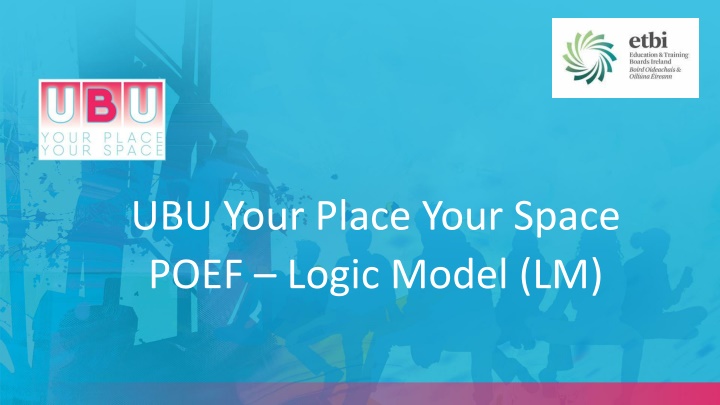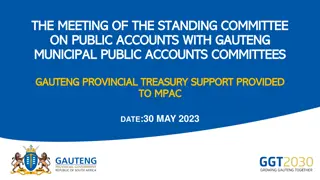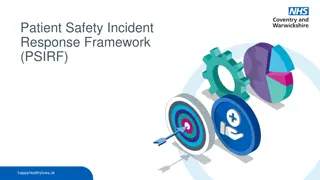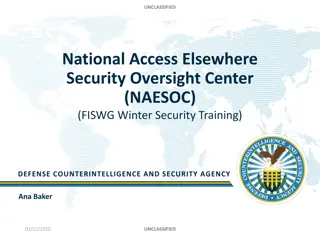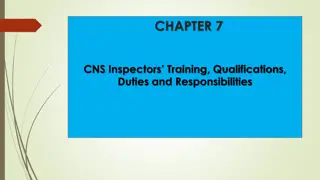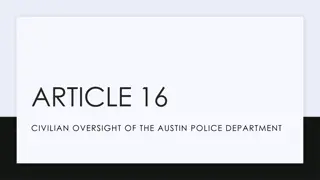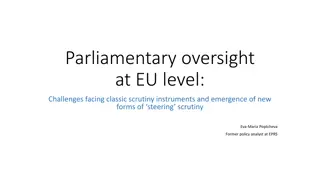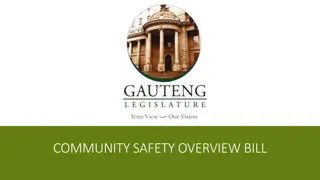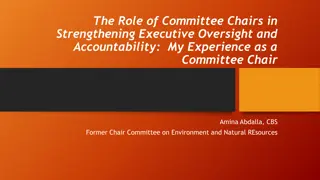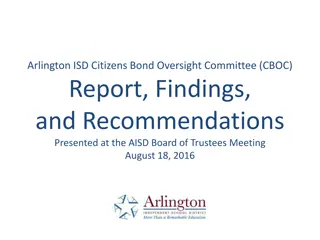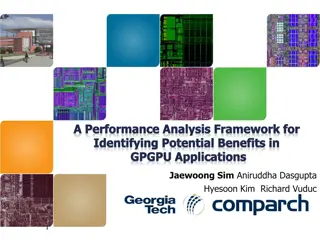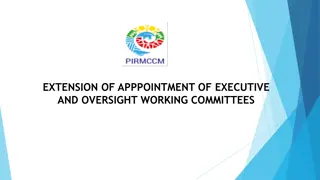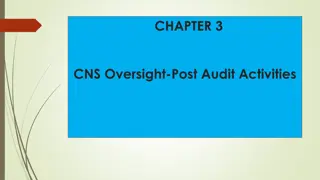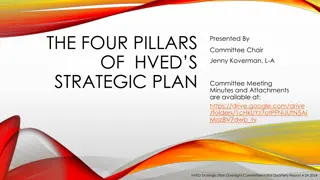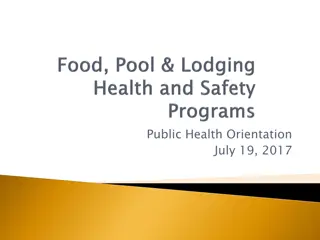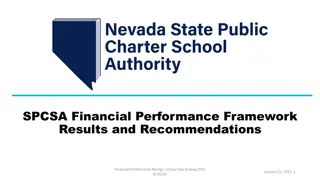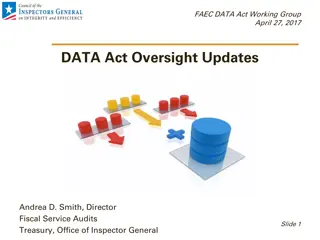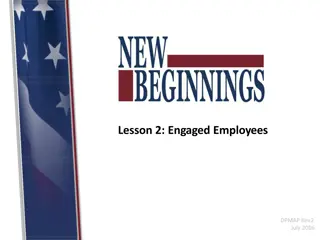UBU Performance Oversight Engagement Framework Overview
Providing an overview of the UBU Logic Model within the UBU Performance Oversight Engagement Framework, this session covers topics such as what a logic model is, best practice principles, getting started, components of the logic model, evidence & monitoring components, and next steps. The framework components work together to establish a shared measurement, monitoring, and planning system across the scheme, including the Logic Model, Planning & Progress Review Meetings, Unannounced Visits, and an Optional Indicative Weekly Timetable to be implemented starting July 2020. Stakeholder roles are defined, specifying the responsibilities of the Funded Organisation and the External Training Body (ETB) in developing and updating the logic model.
Download Presentation

Please find below an Image/Link to download the presentation.
The content on the website is provided AS IS for your information and personal use only. It may not be sold, licensed, or shared on other websites without obtaining consent from the author.If you encounter any issues during the download, it is possible that the publisher has removed the file from their server.
You are allowed to download the files provided on this website for personal or commercial use, subject to the condition that they are used lawfully. All files are the property of their respective owners.
The content on the website is provided AS IS for your information and personal use only. It may not be sold, licensed, or shared on other websites without obtaining consent from the author.
E N D
Presentation Transcript
UBU Your Place Your Space POEF Logic Model (LM)
Purpose Purposeof the Session of the Session Provide an overview of the UBU Logic Model (LM) contained with in the UBU Performance Oversight Engagement Framework (POEF)
Session SessionOutline 1. POEF tools and how the logic model fits 2. What is a logic model? 3. Best Practice Principles, Advantages, challenges, 4. Getting Started Problem Statement, Objectives 5. Outcomes 6. Components of LM Inputs, Activities, Outputs 7. Outputs V Outcomes 8. Evidence & Monitoring Components 9. Next Steps 10.References Outline
The UBU Performance Oversight Engagement Framework (POEF) components work together to provide a shared measurement, monitoring and planning system across the scheme POEF components which will be implemented from July 2020: The Logic Model Planning & Progress Review Meetings (PPRM) Unannounced Visits Indicative Weekly Timetable (Optional)
POEF Component: Impact Measurement Tool: Oversight& Monitoring Tool: Planning Tool: Optional Tool FO: Logic Model (LM) X Planning & Progress Review Meetings (PPRM) X Unannounced visits X Indicative Weekly Timetable
Stakeholder Roles Stakeholder Roles - -POEF Logic Model POEF Logic Model Funded Organisation: Develop the Logic Model to provide a high level visual overview of all work funded under UBU Your Place Your Space Discuss with your ETB the approach to the development of the Logic Model. It can either reflect the full Scheme Cycle or each re-application period. Identify key relevant information to inform the Logic Model. Provide the Logic Model to the ETB Provide an updated version of the Logic Model on, or following, Planning and Progress Review Meetings as required by the ETB. ETB: Provide guidance and feedback to the Funded Organisation on the development of the Logic Model Agree an approach with the Funded Organisation regarding the duration of the Logic model Discuss the content of the Logic Model with the Funded Organisation at Planning and Progress Review Meetings including any amendments required going forward Retain a copy of the Logic Model and file appropriately
Logic Model Logic Model What is it? What is it? a logic model is a great way to tell your story . It describes the resources you need, the activities you plan to carry out, the products of those activities and the resulting impact you intend to achieve. It is often helpful to use the development of a logic model as a programme planning or design tools, as it can help you think through what it will take to achieve the outcomes you have decided on Diagram Story: Diagram Story: What are the problems/issues you are most concerned about What are you going to do to address these What changes are you hoping to create (CCF 2010)
So, Why Logic Modelling: So, Why Logic Modelling: When programs operate in real communities where influences and forces are beyond your control, evaluation is generally more about documenting a program s contribution than about proving something. Community based initiatives operate in complex environments where the scientific certainty of proof is seldom attainable. This is where logic models can be especially helpful. (WK Kellogg Foundation 2004)
A program logic model is merely a snapshot of a program at one point in time. A logic model is a work in progress, a working draft that can be refined as the program develops. (WK Kellogg Foundation2004 ) Classic Logic Model Classic Logic Model If then approach If then approach
Logic Model Best Practice Principles: Logic Model Best Practice Principles: Involve stakeholders LM needs to measure what matters to young people most Keep it simple Remember it s a Snapshot - Revisit, reassess, revise Do not let perfection be the enemy of progress Each Logic Model will be unique
Logic Model Advantages: Logic Model Advantages: Process can build consensus Ensures service providers and funders are all on the same page with regard to what is expected to happen When used effectively, LM can support clarity and provide a positive space for reflection Visual tool can help project/services to step back and embrace the complexity Encourage key stakeholders to ask the right questions. When the model is supported in practice this can result in changes in the way services are provided leading to improved services Explains clearly why and how an intervention logic should work and allows for an explicit critique of why it may not The LM can provide a good structure for discussing how the programme can evaluate its outcomes and tell the story of its success.
Logic Model Challenges: Logic Model Challenges: The Logic Model: is not externally validated and so is less robust than other impact measurement models does not review the value of the work or provide a method for comparing different programmes or objectives involves less opportunity to develop a thorough and deep critique of the underlying assumptions and to challenge the evidence base of the work LM Process: Different ideas reaching consensus can be difficult Division between short- and long- term outcomes and outputs and outcomes can cause confusion If the right people do not participate i.e. those with the most knowledge of services, then the LM can lose meaning and relevance Developing a LM requires a time commitment from practitioners and managers
First.. First.. Scope timeframe for LM & - whole service v part of service/programme element Plan and timeline who will be part of developing your LM e.g. staff, volunteers, young people, management committee, funders etc.
UBU Logic Model Template UBU Logic Model Template READ FROM LEFT TO RIGHT USING IF THEN
Components of a Logic Model Components of a Logic Model Problem Statement: Problem Statement: Describes the issue/need that you intend to meet Answering the questions: What problem does the project/service seek to address? What do we know about the problem? Informed by needs assessment, practice knowledge The target groups are those affected but it is important to note how they are affected.
Components of a Logic Model Components of a Logic Model Objectives: Provides and overriding set of goal statements for an aspect of the services activity SMART state what will be provided for who and when Answering the question: In what ways will the problem/needs be addressed by the project/service ? Frequently objectives will already be identified through the SLA, application form however during the LM process objectives should be reviewed for clarity and relevance
Do the Outcomes first is sage advice. (WK Kellogg Do the Outcomes first is sage advice. (WK Kellogg Foundation 2004) Foundation 2004) 1. Outcomes 2. Inputs take stock of your inputs/resources you might have to refine your outcomes 3. Activities- what will you do with the resources available to bring about the outcomes 4. Outputs defines targets, participation
Outcomes Outcomes outcomes are not about what staff do, they are about what has changed as a result of what staff (or service users) did (Quality Matters, 2013) Outcomes should be: Realistic Specific and measurable Important Supported by evidence Phrased as a change statement
Outcomes Outcomes Short = expect to see Medium = want to see Long = Impact Awareness Knowledge Skills Opinions Aspirations Behaviour Decision making Policies Social action Conditions Sustainable improvement Often contributory and emerge over time 5-7 years Easier to measure Harder to measure
So What? So What? It can take time for stakeholders to get used to thinking in terms of outcomes rather than the activities One way to get a group thinking in terms of outcomes is ask the question so what? Examples: So what if there are 2 drop ins on per week: has anything changed for the young people as a result of this? So what if everyone attended a peer education session: what has changed for the young people?
Inputs Are Your Resources Inputs Are Your Resources List the resources that you currently have for your project/service. If you intend to raise additional resources for the project/service timeframe, account for them under activities and outputs. Types/categories: Human resources: staff & volunteers etc Financial resources: Be specific about these resources, but do not spend a lot of time developing a detailed list of all actual or anticipated expenditure Space: Office and other facilities Technology: Computer etc Other Equipment: Office machinery (printers, copiers) and equipment specific to the programmes or the project Materials/Other: training materials, insurance
Activities Activities Two Key Questions: What will you do with the resources available to bring about the outcomes? What Programmes/actions will you undertake to achieve the objectives? Activities should be: Concrete & Specific Linked to problem statement/objectives ,the resources available and the desired outcomes.
Outputs Outputs Things you can measure while you are actually doing your activity Outputs = quantitative information that describes what happened or what staff did Clearly defines targets, participation etc Generally countable and are Engagement/attendance is an output not an outcome Outputs are quantitative records of what has happened, such as: the number of programmes run, places filled, care plans undertaken, volunteers placed, houses found etc. Outputs can be counted easily and can be considered as the record of what staff have done (Quality Matters 2013)
Outputs V Outcomes Outputs V Outcomes Outputs Doing (tangible completion of the activity) Outcomes effect of the output Example: Billy's 5th birthday party. You go to local bakery and order a Spiderman- themed cake for the party. What is the outcome of this transaction?
Billy's Billy's Birthday Birthday Cake most people will answer that the outcome is the birthday cake That is not correct. the cake is the output provided by the bakery. The outcome of this will be a delighted birthday boy and a group of happy, cake-filled 5-year-olds. If the cake had not been tasty, or if the bakery had delivered a fairy- themed cake instead of the desired Spiderman, then the desired outcome happy kids would, in all probability, not have been achieved. Cake
Evidence Evidence Informing Informing the Rationale/ assumptions Look for strong rationale based on best practice research that connects what you plan to do with why your approach will succeed. Find evidence that supports why you propose the solutions you do. It s a good idea to relate your approach to similar change strategies that have proven effective in communities like yours. Reviewing literature and past evaluation reports from other projects/services (or your own work) will provide you with ample information to construct your rationale the Model Model
Monitoring & Monitoring & Evaluation Tools & Processes to collect information Often, as a result of undertaking the LM, organisations identify new ways of working as well as new ways of capturing information Outcomes for young people you will need to find ways to record/measure distance travelled e.g. Outcome Star1 No UBU specific output and/or outcome measurement tools prescribed in 2020. Youth work projects/services will continue to utilise their bespoke approaches. Evaluation
3 Rs 3 R s - - Revisit, Reassess, Revisit, Reassess,Revise Revise Key Questions: Does it make sense? Is it clear about links? www.innonet.org
Next Next Steps Steps Now that you have created a logic model, put it to work! Use it to build clarity and consensus with colleagues, volunteers, young people, families and the wider community about intended outcomes. Use it to communicate with funders about accomplishments and resource needs. Use it to tell your story to young people, the wider community and media. Use it to evaluate your work a sound logic model is the foundation of effective evaluation.
Thank You ForYour Time & Attention
Resources Resources Referenced: Referenced: Compassion Capital Fund National Resource Centre (CCF), (2010), Strengthening Nonprofits: A Capacity Builders Resource Library, Measuring Outcomes. www.strenghtennonprofits.org WK Kellogg Foundation, (2004), Logic Model Development Guide. www.wkkf.org Gardner, C., Dermody, A, Quigley, M., (2013), Impact Measurement: An Introductory Guide for Irish Social Enterprises & Charities on using LM, Theory of Change & Social Return on Investment to Measure Impact. Quality Matters. www.qualitymatters.ie www.innonet.org
